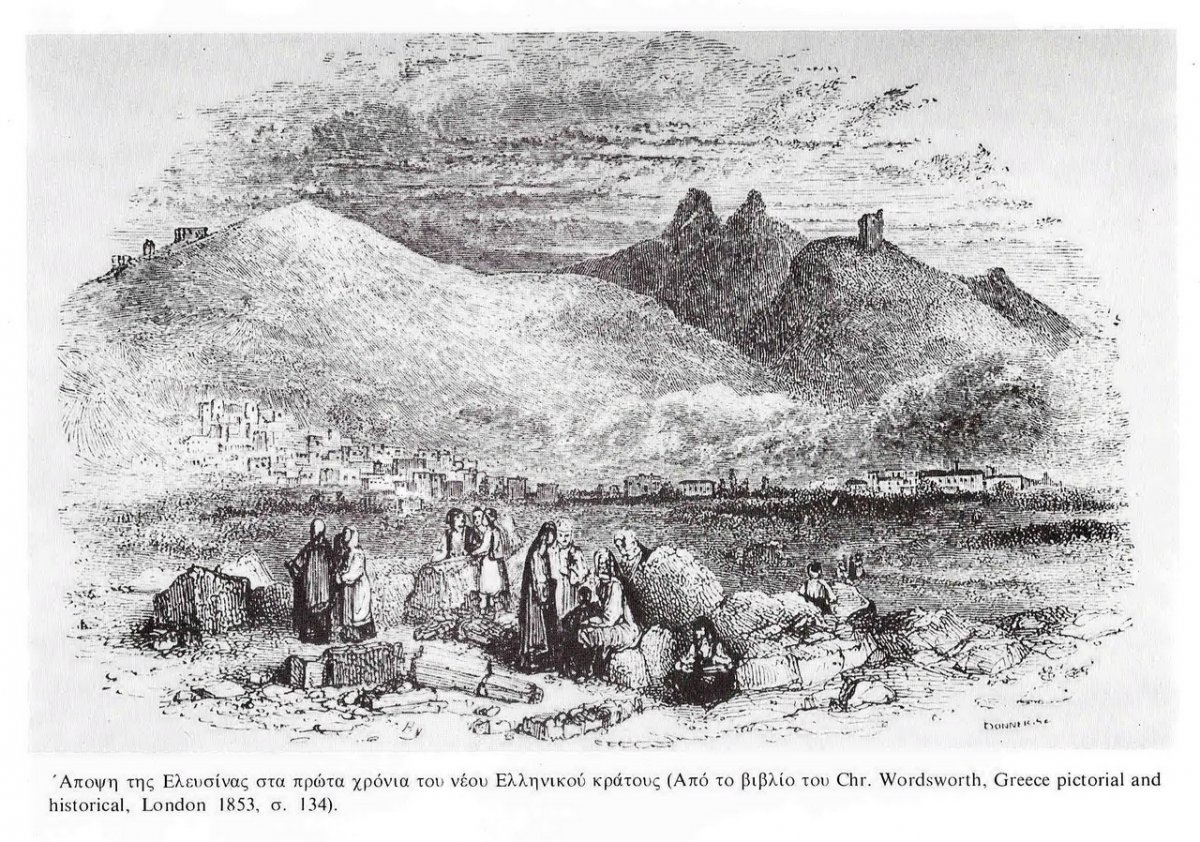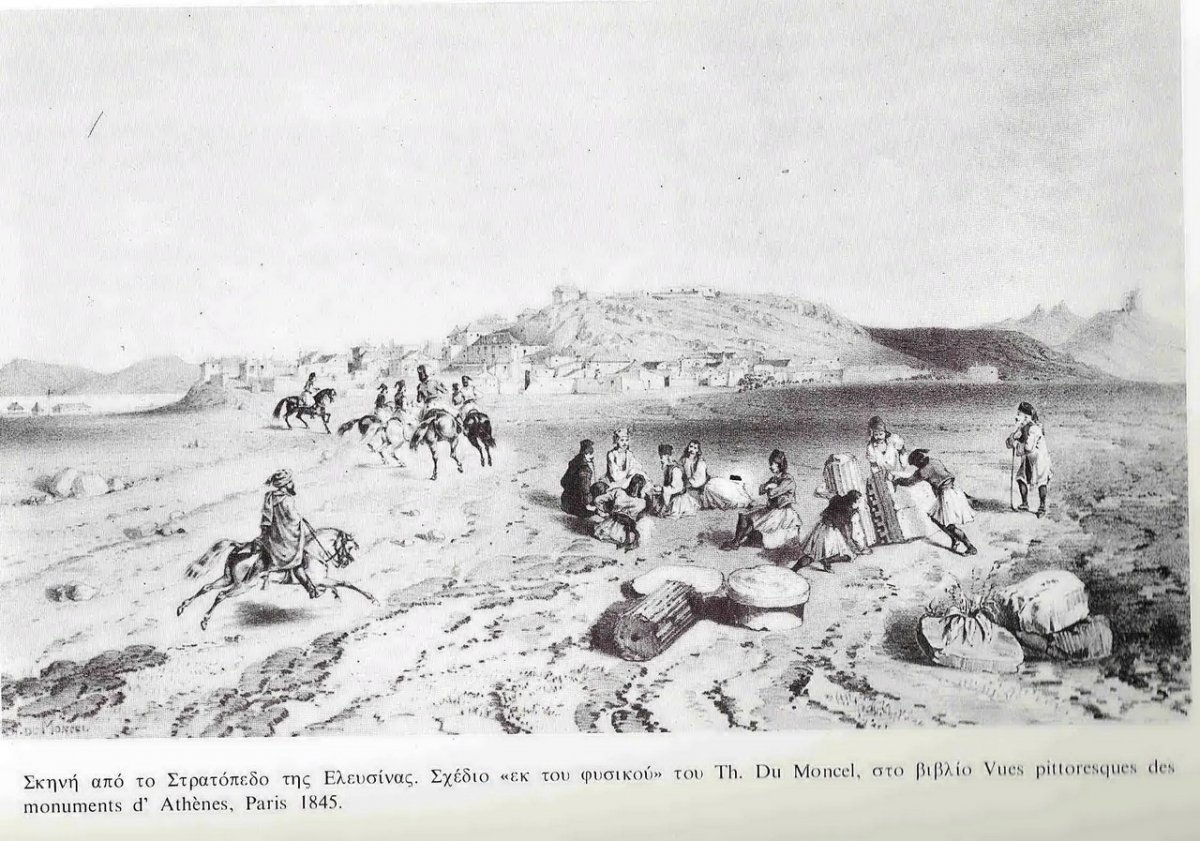Greek Revolution
Elefsis in the Greek Revolution
In 1821, Eleusis was known only for its "camp," which was formed in the final years of the War, at a decisive stage of the Attica operations.
In 1819 and 1820, various enlightened people of the region organized themselves into the Philiki Etaireia.
Yannis Hatzimelitis, Hatzimellitis Raptis, and Anagnostis Stefos organized military units from Kountouriotes and Lepsinotes. The French traveler estimated the number of armed men from the villages of Kountoura and Vilia at 1,590 out of a total of 3,577, aged 15 to 60. Odysseas Androutsos called on the Derbanohoriotes to send him 500 men to Livadia.
The Kountouriotes, who specialized in collecting resin and producing flammable materials such as turpentine, supplied the hydraic fire ships with considerable quantities. In 1822, on the orders of Alexander Mavrokordatos, 3.5 tons of turpentine, 10.5 tons of catram, and 10.5 tons of resin were delivered to the Ministry of the Navy.
During the first year of the struggle, approximately 10,000 women and children were transported to Salamis from the port of Eleusis.
On September 2, 1823, after many attempts, the Executive Body approved the creation of a separate province and the dispatch of representatives to the session of the Parliament. The first representative, Georgios Didaskalopoulos, entered on October 9, 1823.
In 1824, during the most difficult period of the Revolution, when Hellenism was torn apart by civil strife, Eleusis became one of the most important centers of the Struggle in Eastern Central Greece. It was the only center of communication between the Roumeliot troops and the command.
In 1825, Mavrovouniotis and Krieziotis were in the area.
In 1826, Karaiskakis headed for Athens and camped in Eleusis.
The Eleusis camp kept Kioutachis, who had come to capture Athens, pinned down in Thebes for three months.
The names of most of the fighters in the area remain unknown. Approximately 150 names of fighters who settled after the Revolution in Mandra, Magoula, and Elefsina are known, and in 1844 they were nominated for "reward for excellence in battle."
In 1828, the Demogerontia of Dervenochoria was created, to which Elefsina organically belonged. On August 14, 1829, a new administrative authority was established, the "Demogerontia of Megarida," to which Yannis Hatzimelitis, Anagnostis Stefos, and Spyros Berdelis were appointed, with H. Trivizas as secretary.
The arable land of Megarida was estimated at 33,597 stremmas (228 irrigated, 33,3369 dry). One hundred thousand olive trees, 977 stremmas of vineyards.
In 1839, construction began on two roads, one to Megara and one to Thebes, and the port saw some activity as agricultural products from Boeotia were transported to the Peloponnese and the islands.
On May 25, 1842, the "Ypoteloneion Elefsinos" was established, which was subordinate to Piraeus.
On November 25, 1845, a "Health Station" was established to prevent the spread of disease from ship crews.
In January 1849, the "Magistrate's Court of Eleusis" was established, of the third class.
In 1850, the population of Eleusis was 137 families with a total of 585 individuals.
In 1854, an earthquake struck the area, causing the last inhabitants of Kountoura to abandon their homes and descend to the sea.
In 1879, the population reached 1,185.
Between 1837 and 1852, six students are recorded as attending the University of Athens.
In 1860, Eleusis began to change its appearance with the construction of new houses and the establishment of occasional traders to transport the small agricultural and livestock surplus to Athens and Corinth.
Due to the traffic, the government imposed tolls on carts and horses traveling on the national road from Eleusis to Thebes and vice versa.
In 1868, the tolls were extended to the Athens-Eleusis-Megara road, not only for pack animals and carriages but also for cattle and sheep and goats destined for the capital's market.
In 1878, with the declaration of the Russo-Turkish War, hopes for the liberation of other regions, Thessaly, Macedonia, and Epirus, were revived. Two hundred young men from western Attica took part in battles with Megarida MP Georgios Nikolaidis on February 2 and 12, 1878.
In Thessaly, there were many young men in the forces of sub-lieutenant Konstantinos Kriemadis from Vilia.
Contact info
We are the leaders in the building industries and factories. We're word wide. We never give up on the challenges.
- 2 Queen Street,California, USA
- (+84) 04 123 456
- info@example.com



